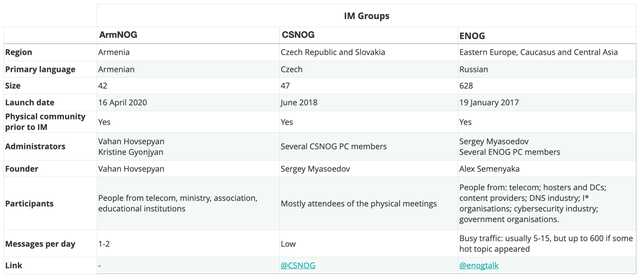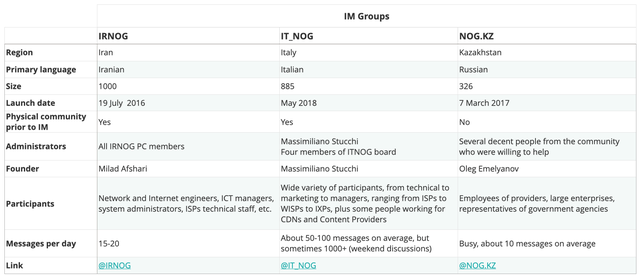Alex Semenyaka takes a look at why and how Network Operator Groups (NOGs) in the RIPE NCC service region are turning to Instant Messengers as their first choice for communication.
Instant messengers (IM) groups are becoming increasingly popular among NOG communities as a means of staying connected and sharing information. A few months ago, I learnt from a colleague, Oleg Emelianov, that there's now a Kazakhstan NOG group (NOG.KZ) on Telegram. As this is the sixth such group created in our service region since we set one up the first for ENOG three years ago, it's a good time to take a closer look at these groups and how they're being used.
To gather more information, I asked the creators of the six NOG IM groups to answer some questions. Tying together their responses with insights I have from running the ENOG Telegram group, I've put together the following in the hope that it might be useful to those of you interested in running an IM group for your own NOG.
Basic Data and Stats


Note: NOG.KZ IM created as @ISP_KZ, re-created as @NOG.KZ on 2 December 2018
Overview
NOG IM groups come in different sizes, ranging from 42 people in ArmNOG to 1000 in IRNOG. In five cases, the face-to-face community already existed when the IM group was created. NOG.KZ was created before any event had taken place. And, as you'd expect, the six groups have a lot else in common.
All the groups are using the same platform; Telegram. The platform is easy to use and has some interesting features that I'll share at the end of the article.
In each case, location and language play a big role. For example, even though ArmNOG and NOG.KZ (Armenia and Kazakhstan) are both part of the ENOG region, they wanted to have their own Telegram group to discuss local issues in Armenian and Russian.
All six groups were created with similar goals: knowledge sharing (ArmNOG, ENOG, IRNOG, NOG.KZ), establishing contacts (NOG.KZ), maintaining discussion between members (ENOG, IRNOG), adding dynamism to communication (CSNOG, IT_NOG). But I’d say that all these groups have achieved much more than that.
All the groups control the signal/noise ratio - but there's always some "noise". I would compare it with the comfort noise in a telephone handset. When someone on a phone hears silence, they tend to wonder what's wrong. Is the connection lost, is the other person still there? To remedy to this issue, telephone equipment is often designed to emit an artificial comforting noise. Similarly, with IM groups, it seems to me that a certain amount of noise - e.g. off-topic messages - may well help participants feel more at ease to speak up and start discussions.
Online vs Face-to-Face
In the survey, representatives of all NOGs pointed out that online communication is no replacement for face-to-face meetings. This was even mentioned by Oleg Yemelyanov from NOG.KZ, although they didn’t have a face-to-face meeting yet.
At an in-person conference, the audience is much more focused on talks and presentations, making for more effective delivery. Also, it's easier to continue a conversation with a smaller group of interested people in person. Reproducing something like this for an online event is challenging. It often involves multiple platforms and doesn’t always feel seamless.
On the other hand, online communication has some benefits. It's arguably much more inclusive, being sometimes easier than face-to-face conversation. This is important, because it's possible to initiate a new broad discussion on almost any topic, while at face-to-face events communication with the audience is focused on the topic from the agenda. The result is that new members end up having access to a larger audience at online events.
For geographically distributed regions, survey participants noted the ease of finding contacts in IM groups. It's much easier to go right to the person you're looking for online; e.g. a representative of some company, or a specialist on a particular issue. Moreover, according to the rules of online communication, it's enough to introduce yourself and get to the point of the question - while in case of face-to-face contact, it is desirable to find someone who could introduce you to the interlocutor.
An interesting and fundamental feature of online communication is the "non-linearity" of the time axis. On one hand, great delays in communication disappear: you can quickly discuss a topic without waiting for a couple of months before a face-to-face meeting, at which point the topic may have lost its relevance. On the other hand, the obligatory "realtime" is cancelled: unlike face-to-face communication, you can decide when to reply.
Thus, face-to-face events and online groups successfully complement each other: the former allows you to concentrate on some specific topics, while the latter provides broad discussions. Face-to-face events provide an opportunity for in-depth and high-quality analysis, and online provides an efficient discussion of news. Both are expanding the community but in different ways.
However, it seems that starting from a certain point, an IM group needs a promotion similar to that of face-to-face events. This may be especially important at the start since the activity in an IM group (and, therefore, its efficiency) depends on its size.
Other Groups and Tools
Four of the NOGs I contacted - ArmNOG, CSNOG, IT_NOG, and ENOG - run mailing lists parallel to their IM groups. In the case of ArmNOG, traffic on the mailing list is comparable to what's seen on the IM group (1-2 messages per day). In the case of CSNOG and ENOG, the mailing lists are used mainly for announcements. The Iranian NOG shut their mailing list down, while NOG.KZ never had one. It is worth mentioning that in the ENOG region, community members complained that they were missing important news despite the existence of a mailing list. ENOG also has a Facebook group but the community seems to prefer Telegram.
In the case of Kazakhstan and the ENOG region, there are parallel independent Telegram groups in Telegram, which are dedicated to the topic of telecom and/or IT. Some of them are smaller than the NOG’s group, some are much more crowded (thousands of participants), but there is no competition between them. There are regular tips for participants of one group to address questions to another where it will likely be better answered. In the case of Iran, there are also parallel independent Telegram groups for telecom people, but the IRNOG group is preferred due to less spam and more focus.
In sum, in comparison to other tools and platforms available, IM groups stand out as the preferred means of keeping informed and staying connected for many participating in these local communities today.
Topics
The most discussed topics fall into three main categories:
- Large-scale network accidents,
- Discussion of parallel events (RIPE Meetings, IETF etc.)
- Regulatory initiatives of governments
Responses to the questionnaire also indicate that a lot of discussion revolves around inter-operator interaction. This includes discussion of network technologies and searches for contacts or recommendations for solving operational problems.
As might be expected, there are often discussions of various technical issues - from the choice of equipment for a specific task to general trends in Internet technologies. An important special case is cybersecurity. For example, DDoS has been the main topic of discussion at IT_NOG for a long time, and the Armenian community coordinated work during an attack on local VAS companies in the Telegram group.
In the case of ENOG, RIPE NCC operations, RIPE policies, and discussions related to Internet Governance were so popular that we were forced to create parallel accompanied groups to accommodate them.
Of course, this could not but lead to the fact that there were quite numerous and diverse examples of solving certain technical issues within Telegram groups only - this was mentioned by 5 founders of these groups out of 6.
ENOG Group Practice
I'd now like to share experience gained from managing the Telegram group of the ENOG community, as it may prove useful to someone else.
Spam
First of all, as mentioned above, we try not to miss different types of spam. Unfortunately, I have to note that spam is often a serious problem in Russian-speaking groups and spammers use a whole arsenal of different techniques. To simplify this fight, we have used several features built in to the platform:
- We have forbidden some participants (except administrators) to add others
- We have limited the frequency of sending messages (not more than one message per 10 seconds)
In addition, an anti-spam bot written by Vladislav Grishenko (@themiron) was added to the group. It effectively uses the combination of CAPTCHA and Bayesian algorithms to prevent spam broadcasting. Being open for free usage by any Telegram group owner, it is a very powerful and useful tool that I would really recommend for everybody.
Speaking of bots, it is also worth noting the GrStatsBot. Recently, Telegram started showing group statistics to administrators of groups with over 500 participants. Earlier, we got similar statistical information from this bot. The main differences are the openness of the data (available to everyone, not just to group administrators) and the ability to use it even with small groups. You can see the result of the bot's work on our group here.
Important Updates
As I mentioned earlier, community members complained that they missed important announcements. Therefore, we have also created a channel @enog_events, which is a companion channel for our group and only used to publish important news (which happens infrequently). One of the convenient features of the Telegram platform is the automatic copying messages from the channel to the associated group. The same applies to "pinned messages" - they get instantly "pinned" both in a channel and in a group.
Note: The difference between a Telegram channel and a Telegram group is that the communication in the channel is one-way, subscribers can read messages there, but cannot reply.
Parallel Groups
Also, two cases when active discussions were detrimental to the whole group were a very important experience for us.
In one case it was discussions on topics related to RIPE policies and practices of RIPE NCC. They were mainly initiated by IP brokers who did not agree with some of RIPE NCC's solutions. Unfortunately, many participants were not very familiar with the basics: how policies are adopted, what responsibilities of LIRs and RIPE NCC are, and so on. Because of this, conversations often went in circles and their constructiveness was really low. But the number of messages per day exceeded the ability of other participants to "digest" them, and they started leaving the group.
In another case, it was about discussing an IG landscape, the role of states on the Internet, and related subjects. Very soon, it turned out that deepening these topics inevitably led to a discussion of political contradictions. Disputes between supporters of different political systems turned out to be very heated, often the parties could not refrain from mutual insults - and although this did not lead to too many offences, the effect was the same as in the previous case: the technical part of the audience began to leave the group.
Both times bans and persuasions did not lead to anything. And both times we solved the problem the same way, by transferring such discussions into parallel groups devoted to the corresponding topics (https://t.me/ripencc and https://t.me/enog_ig correspondingly). These groups were created by other community members to prevent possible prejudices from our side. Now traffic there is on average less than in the main ENOG community group, but both of them are alive and function as intended.
A similar decision was made by IT_NOG where they created a separate group with stricter rules dedicated to reporting the accidents and outages.
Thus, the practice of "branching" groups turns out to be quite successful, when some private topic began to displace all the others, threatening to change the very nature of the original group.
At the same time, two years ago, when the temperature of discussions reached its peak, a parallel group ENOG Flame was also created for "hot heads". The purpose was to bring discussions that have degenerated into pure scolding and insults to this group. I am pleased to note that this group was never needed: after a year of existence without a single message, I deleted it.
Conclusions
Modern platforms provide many opportunities to simplify work with online groups, and the practices of some NOGs can be borrowed by others.
Obviously, one should not try to replace face-to-face NOG events with participation in an online group of even the most advanced messenger. However, organising such a group can help the community not only to save its core, but also to involve new members, identify the community’s topics of interest, and get instant feedback on the events.


Comments 1
The comments section is closed for articles published more than a year ago. If you'd like to inform us of any issues, please contact us.
Vesna Manojlovic •
Hi Alex, here's a blog post from Next Generation Internet about their instant messaging applications - it might be of interest to you & your readers: https://www.ngi.eu/news/2021/01/15/instant-messaging-the-ngi-way/